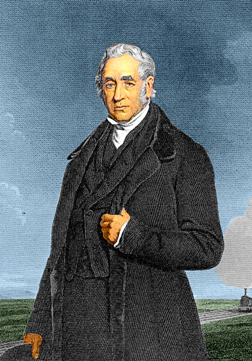Déja vu all over again

As the debate over the proposed HS2 high speed railway hots up, Nina Morgan discovers that some things never change...
William Buckland (1784-1856) first Reader in Geology at Oxford University is perhaps best remembered - in the geological sense - for his work on fossils. But like many of the early geologists, engineering was also apparently well within his remit. As a letter to Buckland from the famous railway engineer, George 'Rocket' Stevenson (picture), preserved in the archives in the Hope Library at the Oxford University Museum of Natural History, illustrates, Buckland was willing and able to lay aside his usual studies to take on a bit of outside consultancy work.
No 35 ½ Great George Street
Westminster
August 1st 1842
My Dear Sir,
I have examined the Line of Railway laid down by you from Oxford to join the Great Western near South Stoke & I have no hesitation whatever in giving my opinion as to its being the best line which could be suggested for connecting Oxford with the above Railway, but also looking to the very small amount of excavation required in its construction, the few roads interfered with, and the inexpensive character of the property intersected. I believe it will be found to apply as many facilities in its construction as any Railway heretofore projected in this country.
In order to forward the proceedings for carrying into effect the proposed Railway, it is most requisite that a powerful & respectable party should be got together to represent the project at Oxford, and thus obviate landed opposition & secure the Bill authorising the completion of the proposed Railway being obtained without the necessity of making any ruinous agreements with Land Owners. – If this be accomplished, I myself and friends are so satisfied of the moderate outlays required for this undertaking, as well as of the Traffic it must command, that we would undertake to lease it for any term of years to be agreed on at 5 per Cent per Annum.
With such prospect, I need only observe that it rests entirely with the inhabitants of Oxford & the Land Owners to come forward to support the scheme with their influence and active co-operation to enable myself and connections to raise any deficiency in the Capital that may be required.
As soon as the views of the principal Land Owners are ascertained and you inform me of the result, I will send an Engineer to level the line previous to the field survey.
I herewith beg to return you the Ordnance sheet with the line laid on.
And remain –
My dear Sir
Very Faithfully Yours
Geo Stephenson
To Professor Buckland
P.S. I hope you will permit yourself to be nominated Chairman of this Company
Definitive evidence as to whether or not Buckland accepted the nomination for the chairmanship of the Great Western Railway is not preserved in the Oxford archives. But the fact that Buckland apparently recycled Stephenson's letter to use as a folder for some notes about glaciation suggests that Buckland - who met his wife-to-be on a train - felt his real interests lay elsewhere.
Acknowledgement
Other sources for this vignette include The Life and Correspondence of William Buckland, D.D., F.R.S, by his daughter, Mrs Gordon, John Murray, 1894 and the DNB entry for George Stephenson. Buckland's recommendation for the railway route was apparently accepted. The 1891 revision of Sheet 13 in the Old Series of the Ordnance Survey maps (reproduced as Sheet 70 Oxford in the David & Charles reprint) which includes the railway lines, shows that the Great Western line from Reading to Oxford passes through South Stoke.
- If the past is the key to your present interests, why not join the History of Geology Group (HOGG). For more information and to read the latest HOGG Newsletter visit the HOGG website at: www.historyofgeologygroup.co.uk, where you’ll also find abstracts for the talks and posters presented at the Conference on Geological Collectors and Collecting, April 2011 available free to download as a pdf file.
*Nina Morgan is a geologist and science writer based near Oxford.